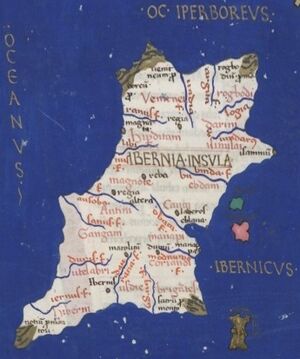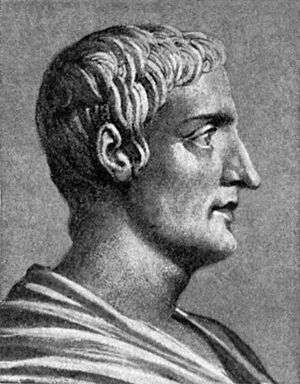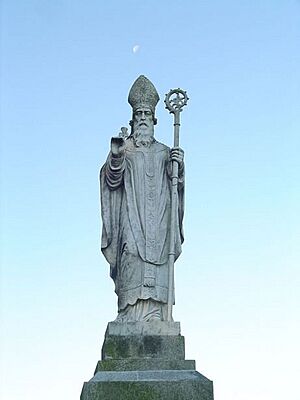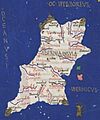Hiberno-Roman relations facts for kids

Hiberno-Roman relations describe the connections between Ireland (also known as Hibernia in Latin) and the powerful Roman Empire. These connections, mostly about trade and culture, happened from about 100 BC to 500 AD. Ireland was special because it was one of the few places in western Europe that the Romans never conquered.
Contents
How Did Rome Influence Ireland?
Even though Rome never took over Ireland and made it part of their empire, they still had some influence on the island. We don't have a lot of proof, but what we do have shows that this influence happened in three main ways:
- Through trade and business.
- Through culture and religion.
- Through military actions or visits.
Trade Between Rome and Ireland
The most common way Rome and Ireland connected was through trade. After the Roman emperor Claudius conquered southern Britannia (modern-day Britain), trade routes from the Mediterranean Sea reached all the way to Ireland.
A geographer named Ptolemy drew a map in the 1st century AD that showed many towns and tribes along Ireland's coast. This suggests that merchants had explored these areas.
Many Roman items, like jewellery and Roman coins, have been found in places like Tara and Cashel in central and southern Ireland. Roman coins were also found at Newgrange. These finds show that people in Ireland traded with the Romans.
Some historians believe that between the 1st and 3rd centuries, people from Ireland were taken to work in rich Roman Britain. Roman farms, called villas, needed many workers. Later, as the Roman Empire became weaker, this might have changed. People from Ireland may have started raiding Britain, similar to how Vikings would later raid across the Irish Sea.
Roman Culture and Religion in Ireland
The Roman Empire also brought new ideas and beliefs to Ireland. Many Irish people became Christians before Saint Patrick arrived.
The first clear historical event in Irish history is when Pope Celestine I sent Palladius to Ireland in 431 AD. Palladius was the first bishop for Irish Christians. This shows that Christians were already living in Ireland before Palladius or Patrick came.
Besides religion, Roman culture also influenced things like clothing. Important people in Irish Celtic tribes in the 3rd and 4th centuries wore clothes that showed Roman influence.
The Ogham alphabet is an ancient Irish writing system. It might have come from the Latin alphabet. This could have happened when Irish people met and married Romanized Britons who knew Latin. However, some experts disagree about this. Many Ogham stones in Wales have writing in both Old Irish and Latin-influenced Brythonic (an old form of Welsh).
Military Connections with Rome
There is some evidence that the Romans might have explored Ireland during the time of Gnaeus Julius Agricola. However, historians still debate what this evidence means.
At places like Drumanagh and Lambay island, some Roman military items have been found. Some historians think Drumanagh might have been a Roman fort or a temporary camp. The most common idea is that any Roman military presence was there to protect traders. Perhaps there was an annual market where Romans and Irish people met to trade.
Other ideas suggest these places were just Roman trading posts. Or they might have been Irish settlements that traded with Roman Britain. Later, as the Roman Empire began to fall apart, Irish tribes raided Britain. They might have brought back Roman knowledge of classical civilization.
Did Romans Ever Land in Ireland?
For a long time, people wondered if Romans ever actually landed in Ireland. In recent years, new ideas have come up. Historian Vittorio di Martino believes that Agricola sent an exploration team to Ireland. This was like an expedition Nero sent to explore southern Sudan.

The Roman historian Tacitus wrote that Agricola, who was governor of Roman Britain (78-84 AD), thought about conquering Ireland. He believed it could be done with just one Roman army group (a Roman legion) and some extra soldiers (auxiliaries). Agricola even hosted an exiled Irish prince, thinking he could use him as an excuse to invade Ireland. Tacitus says that around that time, Agricola had an Irish chieftain with him. This chieftain might have been Túathal Techtmar, who later returned to Ireland with an army.
Digs at places linked to Túathal's story have found Roman items from the late 1st or early 2nd centuries. This fits with the idea that Túathal could have been that chieftain.
Agricola and the leaders who came after him never conquered Ireland. But in recent years, archaeology has shown that Romans might have set foot on the island. Roman and Romano-British items have been found mostly in Leinster. This includes a strong site at Drumanagh, north of Dublin, and graves on nearby Lambay island. Both are close to where Túathal Techtmar is thought to have landed. Other sites linked to Túathal, like Tara and Clogher, also have Roman finds.
However, experts still argue whether these finds show trade, diplomacy, or military action. It's possible that the Romans helped Túathal, or someone like him, get his throne back. This would have given them a friendly neighbor who could stop Irish raids.
The Roman poet Juvenal, who lived in the 2nd century and might have served in Britain with Agricola, wrote that "arms had been taken beyond the shores of Iuverna (Hibernia)". This matches the dates of Agricola's time. Even though Juvenal wasn't writing history, he might have been talking about a real Roman military trip to Ireland, according to Philip Freeman.
Some people also think that a Roman invasion might explain why the Brigantes tribe was in Ireland. The Brigantes were a rebellious British tribe that Agricola had recently conquered. Their leaders, who had lost their land, might have joined Túathal's invasion force. Or the Romans might have sent them to Ireland to get rid of them, just as English rulers later sent rebellious Scots to Ireland. Other tribal names in the southeast of Ireland, like the Domnainn (related to the British Dumnonii) and the Menapii (also known from Gaul, or Roman France), might also come from such an invasion.
The Roman Church in Ireland
Irish religious beliefs slowly became more like Roman ones after Saint Patrick and Saint Palladius began spreading Christianity in Ireland in the 5th century. One of the first churches in Ireland was founded by Saint Palladius in 420 AD. It was called House of the Romans (Teach-na-Roman, now Tigroney). However, direct contact with Rome and Italy was not always steady during this time. There were also connections with Egyptian Christianity.

Saint Patrick, who was from Roman Britain, encouraged the building of monasteries in Ireland. The old druid traditions faded away as the new Christian religion grew. In the monasteries that followed, knowledge of the Latin language was kept alive in Ireland during the Early Middle Ages. This was different from some other parts of Europe, where learning declined after the Roman Empire lost power. However, historians no longer believe that all knowledge was lost during this period. In these monasteries, Irish monks created and spread a type of Latin literature called Hiberno-Latin from the 6th to the 10th centuries.
See also
- Drumanagh
- Túathal Techtmar
- History of Ireland
- Protohistory of Ireland
- Irish Dark Age
Images for kids
-
A map of Hibernia as described by Ptolemy.
-
Tacitus wrote that the Roman general Agricola in 82 crossed the sea (of Ireland?) from western Britain and conquered "tribes unknown" to Romans
-
The Romano-Briton Saint Patrick, Patron Saint of Ireland




